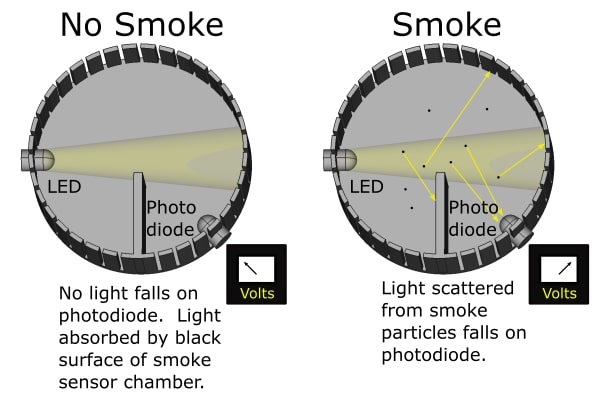Smoke alarms and smoke detectors work by sensing small particles in the air. Once they detect those particles above a certain threshold, they sound the alarm.
There are two main smoke detector types, photoelectric smoke detectors and ionization smoke detectors. In Australia, photoelectric smoke detectors are encouraged and in many cases, required.
Photoelectric technology works by detecting light that is reflected off particles from a light beam inside the sensing chamber. An infrared LED is used as the light source and a photodiode is used as the detector. Refer below to the operation of the smoke sensor chamber without smoke and with smoke.

Photoelectric smoke alarms tend to be more sensitive to particles that are larger in size and white or light-coloured, and thus more reflective, like those emitted by smouldering fires.
Smoke alarm false alarms and nuisance alarms
Any objects that enter the chamber which reflect light are interpreted as smoke. Particles that are not smoke make smoke alarms go off resulting in false alarms and nuisance alarms.
Quality smoke alarms limit the likelihood of non-smoke particle entry into the smoke sensing chamber. For example 1mm mesh insect screens prevent most insect entry.
Quality smoke alarms also use special circuitry or algorithms to prevent false alarms from non-smoke particles. For example to recognize high humidity when opening a bathroom door and the gradual internal build-up of dust over years of detector operating life.
Despite these measures it’s always best to limit non-smoke particle exposure. For instance covering the smoke alarm when spray painting and not locating the smoke detector near bathrooms, garages and clothes dryers.
Once particles have entered the sensing chamber successful cleaning is not always possible.
Smoke detector testing using the test button
While the internal surface of the smoke detector sensing chamber is designed to prevent the bouncing of light through absorption, light absorption is not 100% perfect. That means that even with no smoke in a clean sensing chamber, some light still falls on the sensitive photodiode. This condition facilitates smoke detector testing.
In quality smoke alarms, when the test button is pushed, the smoke alarm, smoke threshold is temporarily lowered to below the ambient light level detected by the photodiode. As a result the alarm sounds in response to the test button being pressed. So pressing the test button successfully tests all parts of the smoke alarm and not just the sounder.
Using a match or a can of smoke spray is not required when testing quality smoke detectors and it can result in a gradual build-up of contaminants inside the smoke sensor. Over time this can cause the smoke detector to generate false alarms.
Conclusion
Photoelectric smoke alarms employ a sensitive smoke sensor to detect light scattering off smoke particles.
Non-smoke particles can also reflect light and lead to nuisance alarms. Quality smoke alarms incorporate features that limit false alarms.
In addition pressing the test button on a quality smoke detector correctly checks that all working parts of the smoke alarm function correctly.